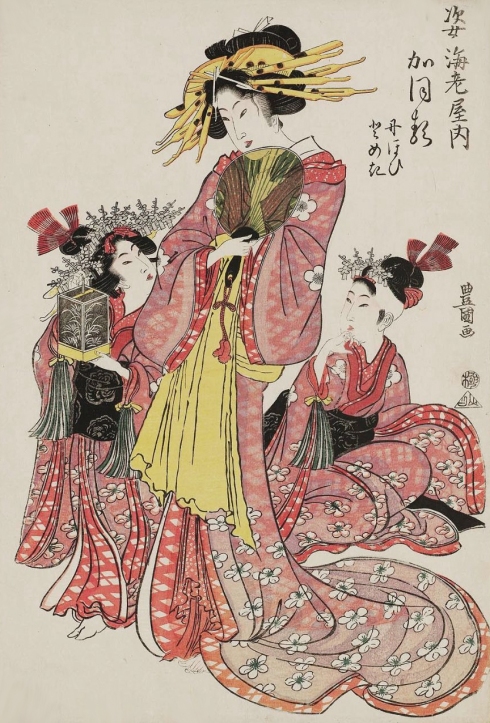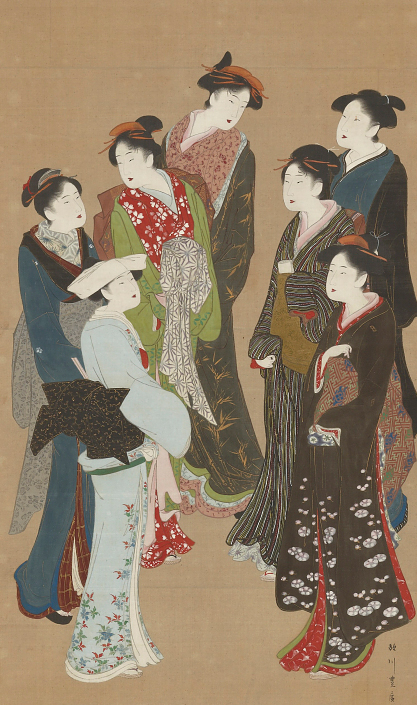Ukiyo-e is a genre of woodblock prints that flourished in the Edo period (1603-1867). Term ‘Ukiyo-e’ literally means ‘pictures of the floating world‘ as it was meant to describe the hedonistic lifestyle of the merchant class that benefited from the rapid economical growth in Edo (modern Tokyo). Merchant class, previously at the bottom of the social order, now had enough wealth to indulge in all sorts of pleasures; from kabuki theatre to services of courtesans and geishas. Courtesan culture also flourished in Edo period, and male wanderers could find a refined female company in the ‘pleasure quarter’. On the other hand, geishas are female entertainers and hostesses, skilled in different areas such as calligraphy or dance. Courtesans were describes as ‘colourful flowers’ while geisha women were called ‘willows’ because of their subtlety, strength, and grace. In addition to all this, merchant class had enough money to afford a new art or design items, depends on how you look at it. I suppose some people really appreciated the beauty of Ukiyo-e prints while others merely enjoyed having them on the wall.
Ukiyo-e prints have a wide range of subjects and styles, depending on the artist and on the time period. The pictures below are my personal favourites, though I’ve also wanted to present you the variety of these artworks and Japanese culture. Woman Bathing Under Flowers is perhaps my top-favourite. However, as a true European my mind instantly compares these works with European artworks of the time. I mean, some of these works were created in the early nineteenth century – the same years that Jane Austen’s novels were written. It’s so exciting to encounter a different era, a different culture, if not in person, than through these lavishing woodblock prints – overwhelmingly simplistic, but dynamic, colourful, scenes from the world gone by.
The great diversity that excites me, and I hope you too, can be traced through the work of the various artists – from the famous Hokusai’s waves or Hiroshige’s nocturnal landscapes to Keisai Eisen’s ‘beautiful women’, Sharaku’s kabuki actors, Torii Kiyonaga’s mystical night scenes, to my personal favourite – Utagawa Toyokuni who, as you can see, focused on everyday scenes, especially women’s activities – bathing, applying makeup, calming hair, strolling in the rain (probably worried for the hairstyle), playing with dogs or cats, dancing or showing off in front of your friends – typical activities of the modern women. It seems like time changes, but people, their worries, fears and passions usually stay the same. Imagine, Utagawa Kunisada’s beauties in the print ‘Autumn moon over Miho’ admired the very same moon we see today.
I must add that Ukiyo-e prints were hugely influential on European art, especially on the Impressionists and Postimpressionist such as Vincent van Gogh who admired some of Hokusai’s prints and also the Japanese way of living.
 1800. Utagawa Toyokuni I (1769-1825) – Woman Bathing Under Flowers, Ukiyo-e woodblock print
1800. Utagawa Toyokuni I (1769-1825) – Woman Bathing Under Flowers, Ukiyo-e woodblock print
 1800. Utagawa Toyokuni I (1769-1825) – Woman in Rain with Umbrella
1800. Utagawa Toyokuni I (1769-1825) – Woman in Rain with Umbrella
 ca. 1810. Utagawa Toyokuni I (1769-1825) – Komachi at Sekidera, from the series ‘Modern Girls as Seven Komachi’
ca. 1810. Utagawa Toyokuni I (1769-1825) – Komachi at Sekidera, from the series ‘Modern Girls as Seven Komachi’
 1800. Utagawa Toyokuni I (1769-1825) – Woman Holding a Cat
1800. Utagawa Toyokuni I (1769-1825) – Woman Holding a Cat
 1800. Utagawa Toyokuni I (1769-1825) – Kaoru of the Sugata-Ebiya, Kamuro Nioi and Tomeki
1800. Utagawa Toyokuni I (1769-1825) – Kaoru of the Sugata-Ebiya, Kamuro Nioi and Tomeki
 1811. Utagawa Toyokuni I (1769-1825) – Beauty under Maple and Ginkgo Leaves
1811. Utagawa Toyokuni I (1769-1825) – Beauty under Maple and Ginkgo Leaves
 Youshuu Chikanobu (1838-1912), Picture of the Hell Courtesan
Youshuu Chikanobu (1838-1912), Picture of the Hell Courtesan
 Korii Koyinaga – Woman Applying Cosmetics, early 19th century
Korii Koyinaga – Woman Applying Cosmetics, early 19th century
 Woman washing her hair with an attendant, Mid 18th century, Katsukawa Shunsui
Woman washing her hair with an attendant, Mid 18th century, Katsukawa Shunsui
 Two women gazing at the reflection of the moon, Early 19th century , Kubo Shunman
Two women gazing at the reflection of the moon, Early 19th century , Kubo Shunman
 Seven classes of women. Color and gold on silk. Early 19th century, Utagawa Toyohiro
Seven classes of women. Color and gold on silk. Early 19th century, Utagawa Toyohiro
 1860. A Leopard Drawn from Life – Kunimaro
1860. A Leopard Drawn from Life – Kunimaro
 Beauties in the Snow By Utamaro Kitagawa (1753-1806)
Beauties in the Snow By Utamaro Kitagawa (1753-1806)
 1796-99 The Courtesan Ichikawa of the Matsuba Establishment – Utamaro
1796-99 The Courtesan Ichikawa of the Matsuba Establishment – Utamaro
 1797 Hairdresser from the series Twelve types of women’s handicraft – Utamaro
1797 Hairdresser from the series Twelve types of women’s handicraft – Utamaro
 Late 18th/early 19th century, Katsushika Hokusai – Courtesan asleep
Late 18th/early 19th century, Katsushika Hokusai – Courtesan asleep
 1767 Two Lovers Beneath an Umbrella in the Snow – Suzuki Harunobu
1767 Two Lovers Beneath an Umbrella in the Snow – Suzuki Harunobu
 1794 The actor Otani Oniji II as Yakko Edobei – Sharaku
1794 The actor Otani Oniji II as Yakko Edobei – Sharaku
 1826-33 The Great Wave off Kanagawa, Hokusai’s most famous print
1826-33 The Great Wave off Kanagawa, Hokusai’s most famous print

1857 Sudden shower over Shin-Ohashi bridge and Atake – Hiroshige

1857 The Plum Garden in Kameido – Hiroshige
 1830s Utagawa Kunisada – Autumn moon over Miho
1830s Utagawa Kunisada – Autumn moon over Miho
 1858 Hiroshige – The Sea at Satta, Suruga Province, from the series ‘Thirty-six Views of Mount Fuji’
1858 Hiroshige – The Sea at Satta, Suruga Province, from the series ‘Thirty-six Views of Mount Fuji’






An interesting post, I personally am not a great fan of eastern art, the way they draw people and the overall style does not appeal to my taste. But I actually quite like some of the pictures you have shown here, the composition, colours and simple lines are quite good in some of them, especially the landscape ones. I particularly like ‘The Plum garden’, ‘beauties in the snow’ and ‘two lovers underneath an umbrella in the snow’.
LikeLike
I understand you completely, for, even as a big art fan, some artists just really don’t appeal to me, I don’t like Picasso that much, to be honest. I’m glad though that you liked some of these ukiyo-e pictures. Japanese landscapes are interesting, I like the way they painted waves.
Seems like you and van Gogh have similar tastes, for he too liked the picture ‘The plum garden’, and in fact painted something inspired by that particular ukiyo-e print. If you want to see it, I’ve written about it here: https://byronsmuse.wordpress.com/2014/08/16/van-gogh-japonaiserie/
LikeLiked by 1 person
I hope this site is still active as I badly need a guide. I’ve just retired and am now hoping to have the time to do everything I intended to do before I got a kick in the but by life.
Being new to this area of art, I am still struggling to figure out how to tell if I’m looking at Chinese or Japanies art. Reciently, I picked up a lot of ten wonderful framed prints at a local (Western Maine, USA) auction. They were sold as Chinese art. While trying to research them I came upon your blog. Imagine my surprise at finding one of my prints on your site. Well, a part of one that is.
This brings me to the question driving me to disturb you with my confusion. The amazing print, Beauties in the Snow By Utamaro Kitagawa (1753-1806) and the supposedly Chinese print I bought are awkwardly similer. My ladies apear to be the exact same but the background in my print has water, mountains and a light snow falling. Having now seen the original, I’m troubled by the way the front lady is hunch over into the softly falling snowas compared to the blizard the original’s women are forced to endure.
Is this a normal thing to find? Is some Chinese artist stealing from Utamaro Kitagawa? Did the artist use differant backgrounds with the same focus? If you can offer any inlightenment as to just what I’m looking atI would be extreamly gratefull.
HFB
West Paris
Maine
LikeLiked by 1 person
Pardon my poor spelling. I married my long suffering wife Linda 50 years ago presicely to oversee my problem in those precarious days before spell check.
HFB
LikeLike
Hello there, I am thrilled you wrote to me about your Japanese vs Chinese art dilemmas but I am afraid that, unfortunately, I am not very helpful. I love Ukiyo-e prints, but I am only an art history student, not a connoisseur on the topic of Asian art. I don’t have the practical experience of holding the pieces in my hand and investigating them to make it clear which art they belong to. My knowledge is more imagination and book based when it comes to art. I don’t know much about Chinese art either, though I know that Japanese Ukiyo-e prints were inspired by Chinese ones. So I would say it’s more likely that Kitagawa was inspired by some Chinese artist.
LikeLike
Hi, I love the 1797-hairdresser-from-the-series-twelve-types-of-womens-handcraft-utamaro, picture. How much is it selling for and where can I purchase it?
LikeLike
I don’t know, I am not selling art or dealing in art, I write about art from aesthetic point of view and I don’t care about art market.
LikeLike